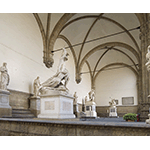Loggia della Signoria
Between 1376 and 1382, Benci di Cione and Simone Talenti erected a loggia designed by Orcagna, in the Piazza della Signoria. Also known as the Loggia dei Lanzi (after the Landsknechts who camped out there) or Loggia dell’Orcagna (after Andrea di Cione Arcangelo, known as Orcagna, who perhaps supplied the plan), the loggia houses a series of famous sculptures which form a sort of "open-air museum". Around the mid 16th century, passing through Florence, French naturalist Guillaume Rondelet, author of a famous treatise on fish, observed the carcass of a sperm whale, exhibited to the amazement and enthusiasm of passers-by. An inscription in Latin on the right wall recalls the adoption, at the end of 1749, of the common calendar (known as Gregorian and already used elsewhere as of 1582) in substitution of the Florentine calendar, which started on March 25 and was called ab incarnatione, precisely because it started nine months before Christmas.
In the second half of the 16th century, Bernardo Buontalenti provided the loggia terrace, accessible from the Uffizi Gallery, with a sort of hanging garden for the use of the grand-ducal family.
In 1859, the then Minister of Public Education in Tuscany, Cosimo Ridolfi entrusted Filippo Cecchi and Giovanni Antonelli with the construction of a large balance barometer and a metal thermometer to place inside the Loggia. Cecchi declared that the intention was to make «the public familiar with the use of a very useful kind of weather observation». The choice of such a prestigious venue for the installation of weather instruments represented a strong recognition of scientific knowledge. The happy union between art and science, however, did not last for long: around the 1930s, in the name of aesthetic criteria, the city authorities decided to disassemble the instruments and transfer them to the store-rooms of the Uffizi. The Institute and Museum of History of Science today preserves the surviving pieces of the instruments’ dials.
****************************
Texts by Graziano Magrini
English translation by Victor Beard
Last update 01/feb/2008




